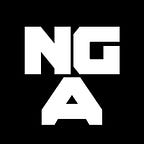Excuse me!
Artist Kate Beynon talks to Liminal editor Leah Jing McIntosh about identity, art and Infinite conversations, now in its final week at the NGA.
Infinite conversations: Asian-Australian artistic exchange fills two spacious galleries at the NGA. The first gallery comprises works of art made by Chinese artists who settled in Australia after the 1989 Tiananmen Square protests. In 2018, these pieces still pose important questions: what does it mean to be Asian within Australia? How can one be both Asian and Australian? And what does it mean to fall somewhere in between?
The works of art in the second gallery consider broader cultural exchange between Asian and Australian artists since the late 1980s. Kate Beynon’s Excuse me! (1997) is perfectly positioned as a link between the two spaces, presenting viewers with a fascinating interrogation of language and cultural divides.
I talked to Beynon about her work, the weight of language, and what being Asian-Australian means to her.
LJ: When considering Excuse me!, the title of the exhibition Infinite conversations suddenly feels quite heavy. You created this piece in 1997, yet it feels quite pertinent to life in 2018. Do you think these conversations on race and culture will require infinite interrogation?
KB: Excuse me! is about different ways of approaching language, text and communicating. Initially I saw the title Infinite conversations as positive and optimistic, because I related it to the connections between the artists and artworks in the exhibition, and the potential communication with visitors.
But in having said that, I can also understand your point about the heaviness, especially with the ongoing oppressions and inequalities that definitely need continued resistance and interrogation in our contemporary world.
LJ: You flip the clichéd question, ‘Where are you really from’, often directed at non-white people, so that the viewer is interrogated in Chinese. Was this inversion intentional?
KB: Having grown up not speaking Chinese, the speech bubble text in Excuse me! is taken from the phrase book I used when visiting China in 1995 as a young emerging artist, where I studied and attempted to learn Chinese speaking and writing. So besides Excuse me! — which has ambiguous intentions as it can be said in jest, with sarcasm, irony or as an actual request [to repeat a word or phrase] — the work features simple phrases for communicating and socialising when travelling, such as: ‘Please speak more slowly’, ‘How are you?’ and ‘Right!’.
It was not my intention to shut viewers out but encourage them to consider language, translation and forms of communication. However, flipping the interrogation definitely played a role in my early works. Around the same time as Excuse me! I made the What people series — wall drawing figures who had the characters for ‘What!’ emblazoned on the foreheads. They challenged the ‘where are you really from?’ question which often comes across as a ‘what are you?’ question.
Excuse me! is about language in one sense, but it is also about looking at forms of writing and text. I like how, by nature, some Chinese character styles can be appreciated for their calligraphic form and energy rather than literal meaning, so I also had this in mind when forming the characters.
LJ: What would you hope a viewer would take away from Excuse me!?
KB: Whether legible or not, I hope visitors might experience the fluffy red characters somewhere in-between drawing, writing and soft sculpture — and find interest in the unusual materials, as the work is entirely made in chenille sticks.
In Infinite conversations, Excuse me! is installed next to my painting Self-portrait with dragon spirits, a more recent work from 2010. In a way, both works are forms of self-portraits. Amongst the comic book-like figures in Excuse me! there is one that is based on a self-portrait at that time, and one of my partner Mike. There’s also a small figure with wavy hair, who could be a premonition of our son Rali, born two years later.
LJ: I ask this question to all of our Liminal interviewees, and think it is also pertinent to both your work and the Infinite conversations exhibition: what does being Asian-Australian mean to you?
KB: When I was young I struggled with ‘in-between-ness’– a feeling of not fitting, or not really belonging — growing up in Australia, or on visits to maternal grandparents in Malaysia, or paternal relatives in the U.K, or my birthplace of Hong Kong. When I grew to think more about identity being hybrid, flexible and not so fixed, I could understand this feeling in a positive sense.
For me, being Asian-Australian, Eurasian, of migrant background and a woman artist of colour means embracing a mixt cultural identity. I see our son Rali (now 19) as extending a positive idea of being mixt with his distinctive blend of Afro-Caribbean-Latin-Native-American-Euro-Celtic-Nordic-Asian ancestries, while also being Australian-born. I’m proud of his eclectic mix — and his amazing and abundant afro hair!
I feel a solidarity with many Asian-Australians and people of colour from diverse backgrounds and blends, and our allies. Meeting other artists and exhibiting together has been a wonderful way to be inspired, gain insight and make connections.
Respect and inclusiveness for POC is an ongoing issue in mainstream culture and life. Proper respect for POC, including from refugee and recent migrant backgrounds, alongside acknowledgement and deep respect for First Nations Australians, forges positive cultural connections between us all.
Being Asian-Australian also means celebrating one of the highlights of the year — a very mixt and extended family Chinese & Lunar New Year feast!
Infinite Conversations, featured in the Australian Art Galleries, has been extended for public view until September 19, 2018.
Leah Jing edits Liminal, an online space for the exploration of the Asian-Australian experience. Find her at @_leahleahleah and @liminalmag
